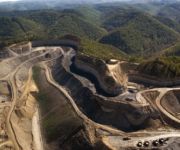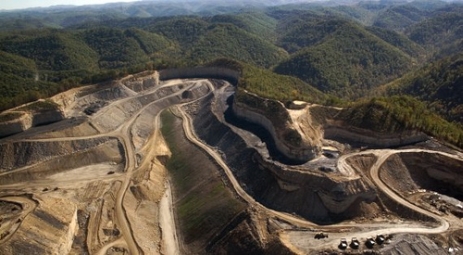 Scientists would shout this from the mountaintops, but …Photo: farukahmet via Creative CommonsLet’s say you trundle a bunch of enormous industrial equipment into North America’s oldest mountains (an intact temperate ecosystem boasting rich biodiversity, including a number of endangered species), clear-cut the forests, blow millions of tons off the top of the mountains, dump the rubble into the pristine streams below, and carry out the coal you find on enormous trucks, at high speeds, on narrow roads, through some of America’s oldest communities.
Scientists would shout this from the mountaintops, but …Photo: farukahmet via Creative CommonsLet’s say you trundle a bunch of enormous industrial equipment into North America’s oldest mountains (an intact temperate ecosystem boasting rich biodiversity, including a number of endangered species), clear-cut the forests, blow millions of tons off the top of the mountains, dump the rubble into the pristine streams below, and carry out the coal you find on enormous trucks, at high speeds, on narrow roads, through some of America’s oldest communities.
Think that would cause any ecological or human damage? Hmm …
It might seem obvious, but as the media will tell you, “opinions on shape of earth differ,” so it’s helpful that a group of scientists has come along to assess the existing body of research on the subject.
And what does Science say? Yes, blowing up mountains causes environmental and health damage! Who woulda thunk it? In fact, the evidence is so clear that the scientists have taken the extraordinary further step of calling for an immediate moratorium on mountaintop removal mining permits.
The information is contained in a new paper being published today in the journal Science: “Mountaintop Mining Consequences.” From the press release:
Based on a comprehensive analysis of the latest scientific findings and new data, a group of the nation’s leading environmental scientists are calling on the U.S. Environmental Protection Agency and the U.S. Army Corps of Engineers to stay all new mountaintop mining permits. In the January 8 edition of the journal Science, they argue that peer-reviewed research unequivocally documents irreversible environmental impacts from this form of mining which also exposes local residents to a higher risk of serious health problems.
…
Co-author Dr. Emily Bernhardt, of Duke University, explains that “The chemicals released into streams from valley fills contain a variety of ions and trace metals which are toxic or debilitating for many organisms, which explains why biodiversity is reduced below valley fills.” The authors provide evidence that mine reclamation and mitigation practices have not prevented the contaminants from moving into downstream waters.
The authors also describe human health impacts associated with surface mining for coal in the Appalachian region, including elevated rates of mortality, lung cancer, and chronic heart, lung and kidney disease in coal producing communities.
“Over the last 30 years, there has been a global increase in surface mining, and it is now the dominant driver of land-use change in the Central Appalachian region,” says Dr. Keith Eshleman also of the University of Maryland Center for Environmental Science. “We now know that surface mining has extraordinary consequences for both aquatic and terrestrial ecosystems. Notwithstanding recent attempts to improve reclamation, the immense scale of mountaintop mining makes it unrealistic to think that true restoration or mitigation is possible with current techniques.”
Ironically, this comes on the heels of the Obama administration’s decision to approve a new MTR permit in West Virginia. Perhaps the EPA doesn’t believe that blowing up mountains harms mountains?
UPDATE: I’m listening to a conference call with some of the scientists who wrote the paper. It’s a real horror show.
The forests that get cleared store tons of carbon; the vegetation it’s replaced with doesn’t. So there’s a climate change connection (aside from the obvious coal connection).
Blowing all this stuff destroys the landscapes ability to absorb rainfall, which leads to increased flooding downstream. And those effects are expected to persist for centuries.
The industry claims it’s “replacing” headwater Appalachian streams, but you won’t be surprised to hear that hydrologists find that claim absurd. The hydrology ends up different and the streams end up polluted with trace metals (poisoning those downstream). These trace metals are also associated with decline in invertebrate biodiversity.
Permits are considered individually, but multiple permits granted in the same watershed leads to additive effects that persist for decades after abandonment.
Concentrations of selenium in the water bioaccumulate in the food chain and effects are magnified. The fish become poisonous.
And of course the human toll: poisoned water leads to more deformities in babies and worse academic outcomes. Air quality is degraded, leading to respiratory diseases. And on and on.
God this is depressing. I wonder how Don Blankenship feels about it.
UPDATE 2: Now in Q&A with the scientists. One says, “this is the most heavily peer-reviewed paper I’ve ever published — one review was 18 pages long.”
The scientists received no outside funding for this; they donated their time. One says the project was sparked by a request from NGOs.
They’re calling for a moratorium on permits until there can be a “rational hearing” on the science. Many of them were new to the issue when they started this; all of them seem kind of shocked by how horrific it is and by how little attention it’s gotten.
Asked about new permit just issued for Hobet 45 mine, Dr. Dennis Lemly says the water issue weren’t addressed. “This is just business as usual.”
One problem with permits: they only address valley fill area. But pollutants escape and many of their cumulative effects are felt downstream.
Asked: are there technological options available to deal with the water quality properly? Lemly: sure, it’s just a matter of cost. Dr. William Schlesinger adds: when you bury a stream, it’s gone. There’s no replicating it.
Dr. Emily Bernhardt: part of impetus of the paper was to provide regulators with a comprehensive overview. Met with a small group from U.S. EPA to present findings.
Bernhardt: all the data mining companies and the WV DEP collect information on surface water, but much of the pollution is found beneath the surface in water tables.
To me, the most amazing part of all this — and clearly the scientists are amazed as well — is the fact that there’s never been a comprehensive assessment of MTR impacts before. We’re blowing up mountains and we have no idea what the consequences are! The mind boggles. It’s like the whole country is just discovering Appalachia.



